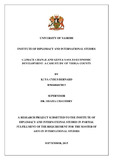| dc.description.abstract | Climate change and natural disasters have disrupted the socio-economic development of
Kenya, witnessed through the concurrent drought seasons, flooding seasons and the changes
in the rainfall and temperature variation. These effects have tremendously affected the socioeconomic
developments within the county levels as key economic pillars such as agriculture,
tourism, mining and industrial sectors which depend mainly on climatic factors being
affected. These are mainly attributed to the country’s overdependence on rain-fed agriculture
hence exposing the country to food insecurity as the majority of the economic pillars sectors
are climate sensitive. Kenya has been significantly affected by climate change catastrophe
with droughts and floods taking centre stage. According to statistics, the 1997/1998 El Nino
floods and the 1999/2000 La Nina drought is estimated to have cost at least 14% of Kenya's
GDP each year and it is predicted to have a negative impact in the near future if nothing is
done to mitigate and adapt to future climate change events. This study examines the socioeconomic
impacts of climate change in Kenya, key challenges facing climate change
mitigation and adaptation in the country and analyses how climate change has hindered major
socio-economic development at the grassroots level. The study theoretical analysis is
premised on the assumption of organisation, individuals and even countries to work on the
good of the society at large by protecting the eco-system. This is geared towards the efforts of
the government to educate the masses on the need to protect the environment and to
implement workable environmental policies. The qualitative results have shown that Kenya's
socio-economic development is heavily influenced by climatic conditions in almost all
sectors, having a negative trend in the growth and development of the country. Human socioeconomic
activities such as deforestation, poor farming patterns, destruction of water
catchment areas and emission of GHG are the key contributors to climatic changes. The key
findings have indicated that Kenya socio-economic development is heavily influenced by
changes in climatic conditions, evident through the over-dependence on rain-fed agriculture,
with agriculture being the main socio-economic driver of the country. Moreover, the findings
indicated that there is little/no knowledge about climate change adaptation within the public,
hence the continuous environmental degradation. This is mainly attributed to the inactive role
taken by the government towards mitigating and adapting to climate change, and also a lack
of a proactive institution to champion for the same. Organisations and climate change
stakeholders both regionally and internationally should take an active role in championing for climate change adaptation and mitigation. | en_US |

